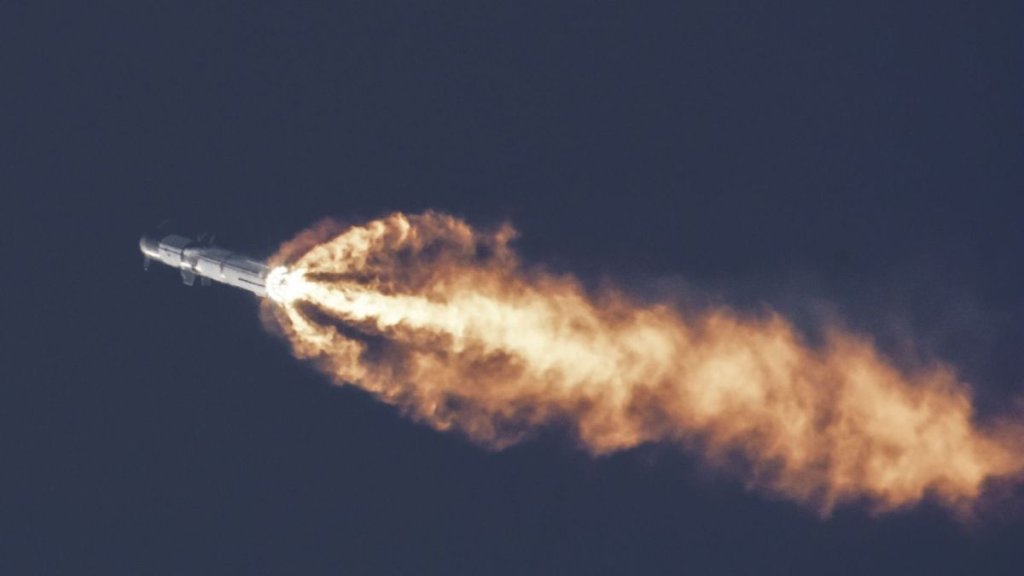SpaceX apparently has some cleaning up to do after the long-awaited debut flight of its giant Starship vehicle.
A fully stacked Starship launched for the first time ever yesterday (April 20), rising off the orbital mount at SpaceX’s Starbase facility in South Texas atop a towering pillar of flame.
The goal was to get Starship‘s upper stage to space, then ultimately bring it down in the Pacific Ocean near Hawaii. But that didn’t happen: Starship ran into several problems a few minutes after liftoff, and SpaceX commanded the destruction of the 394-foot-tall (120 meters) craft high above the Gulf of Mexico.
SpaceX celebrated the test flight nonetheless, highlighting the milestones Starship achieved. It flew relatively high, for example, getting a maximum of 24 miles (39 kilometers) above Earth. And it survived Max-Q, the point in a flight when the stresses on a rocket are the highest.
“Congrats @SpaceX team on an exciting test launch of Starship! Learned a lot for next test launch in a few months,” company founder and CEO Elon Musk said via Twitter yesterday (opens in new tab), shortly after the test flight’s explosive conclusion.
Related: Relive SpaceX’s explosive 1st Starship test flight in these incredible launch photos
That tweet encapsulates the strategy that has taken SpaceX to the top of the launch industry: Build, test and iterate rapidly, learning immensely from the failures that occur along the way.
Musk’s suggested timeline may seem a bit optimistic, however, because yesterday’s liftoff apparently took a massive toll on Starbase’s orbital launch mount and some of its support infrastructure.
SpaceX has yet to release post-launch photos of the Starship pad, but reputable sources indicate that the damage wrought by Starship’s 33 first-stage Raptor engines was considerable.
Here’s a look at the debris-strewn launch pad at SpaceX’s Starbase facility in Texas following this morning’s Starship test flight.The launch of the world’s largest rocket also left a large crater in the concrete under the launch mount.📷: @LabPadre https://t.co/4Qlst35wgT pic.twitter.com/rIS3LVkPTYApril 20, 2023
The launch “left a large crater in the concrete under the launch mount,” Spaceflight Now said yesterday (opens in new tab) in a tweet that included several photos of the debris-strewn pad. In a tweet today (opens in new tab), the outlet described the orbital mount as “heavily damaged.”
A small crew has arrived at the heavily damaged Starship pad following yesterday’s launch. Watch live: https://t.co/McQ3KV5CV2 pic.twitter.com/nFH3eEikTiApril 21, 2023
Max Evans, a photographer for NASASpaceflight.com, posted a Twitter thread (opens in new tab) today that documents some of that damage. “Tough to imagine this site being usable again in under a 12-month timeline — would be happy to be proven wrong,” Evans wrote in one of the tweets (opens in new tab).
Engineer and space entrepreneur Jonathan Goff — who co-founded Masten Space Systems, founded Altius Space Systems and now works to develop commercial space stations at Gravitics, Inc. — was more optimistic about the repair timeline, but only slightly.
“I think with the pad damage and need to rework the launch infrastructure, that we’re probably at least 7-9 mos out from our next SS/SH flight of any kind. 1 yr to get to a fully orbital and successful flight was being very optimistic,” Goff tweeted today (opens in new tab). (SS/SH refers to Starship and Super Heavy, the names for the second and first stages of the giant SpaceX vehicle, respectively.)
Tough to imagine this site being usable again in under a 12-month timeline – would be happy to be proven wrong. pic.twitter.com/0Keg4xunr3April 21, 2023
These posts were published before Musk weighed in again, however. In a tweeted reply to Ars Technica’s Eric Berger on Twitter this afternoon (opens in new tab), Musk said that SpaceX could be “ready to launch again in 1 to 2 months.”
The billionaire entrepreneur added that the company began building “a massive water-cooled, steel plate to go under the launch mount” three months ago. This plate wasn’t ready in time for yesterday’s launch, but SpaceX went ahead with the mission anyway, Musk said, figuring that the concrete under the Starbase pad (a formula known as Fondag) would survive a single liftoff.
This assessment was incorrect, Musk noted. Presumably, the steel plate will be installed before Starship test flight number two.
3 months ago, we started building a massive water-cooled, steel plate to go under the launch mount. Wasn’t ready in time & we wrongly thought, based on static fire data, that Fondag would make it through 1 launch.Looks like we can be ready to launch again in 1 to 2 months.April 21, 2023
So SpaceX’s various Starship teams will doubtless be very busy over the coming weeks. In addition to the Starbase repairs and plate installation, they’ll be analyzing data from the debut flight, incorporating the lessons learned into future Starships and getting the next vehicle in line ready for flight.
Will all that work be done just a few months or so? It seems like a stretch, but SpaceX has a history of filling tall orders.
Editor’s note: This story was updated at 5:55 p.m. EDT on April 21 to include Elon Musk’s tweet about the water-cooled steel plate that SpaceX plans to install beneath Starbase’s orbital launch mount.
Mike Wall is the author of “Out There (opens in new tab)” (Grand Central Publishing, 2018; illustrated by Karl Tate), a book about the search for alien life. Follow him on Twitter @michaeldwall (opens in new tab). Follow us on Twitter @Spacedotcom (opens in new tab) or Facebook (opens in new tab).

